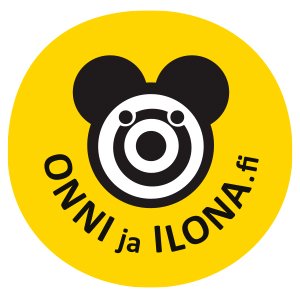Baby vision - research findings
Even very small babies like to look at different patterns. For decades, psychologists have studied how babies look at things and have discovered that babies prefer certain images and patterns
For my graphical design studies thesis, I familiarised myself with the scientific literature on how infants look at things. Baby's vision section contains the essential content of my thesis.
Inspired by the research results that I encountered, I designed the Onni ja Ilona pictures - Happy art for babies. Primarily, I am an illustrator, and the people involved in the research area are familiar with the latest results of infant studies and have the best understanding of babies.
Infant vision: the importance of contrast
Even a new-born can see, but they do not see like an adult. The eyesight of a new-born is often described as being like an unfocused photograph: some dark and light areas take form in the field of vision, but as a highly fuzzy image. A small infant can only discern patterns if they have a high enough contrast. For this very reason, a small infant prefers a black-and-white pattern.
Distance: lap and mother's face
A very small baby cannot yet see far, either. According to studies, the distance at which a new-born sees best is 20 cm. This is about the distance from which the new-born sees the face of its mother during breast-feeding. A one-month-old infant can see further, up to about a metre. By the age of one year, the eyesight of a baby is already close to that of an adult. Therefore, any flash card used with a baby's should be presented close enough, so that the baby sees it and becomes interested.
A new-born and a six-month-old have their own preferences
A small infant develops at an immense speed, and this includes their visual capacity. This is why the viewing preferences of a new-born or one-month-old is partially different from that of a six-month-old. In a nutshell, it can be stated that the favourite patterns of a very small baby are bigger and fewer in number; simpler. As the months go by, variety in an image and a higher number of elements start to be preferred.
Favourite patterns: checkerboard, centralised circle, face
In addition to high contrast and a high number of elements, babies have been found to prefer certain patterns. Curved lines, corners or concentricity, for example, are elements to which babies are known to react. There are also favourites among entire patterns, such as a checkerboard or a centralised circle pattern; that is, a bull's eye. However, babies' preferences for these different elements vary with age. A simple smiley face that resembles a real face is the favourite of babies of almost any age.
Baby's favourite colour
Babies from new-born infants to one-month-olds are still not able to discern colours, with the possible exception of red. By the age of two months, orange, blue and purple and bluish-green also stand out from a white background. From three months onwards, a baby can probably see all of the colours, although not as many shades as an adult.
From the age of three months onwards, babies become more interested in some colours than others. In several studies, red, blue and purple have been found to be the favourite colours of babies. Orange and yellow seem to be in the middle regarding preference. The least popular colours are green, pink and brown, in that order.
A black-and-white image with a high contrast beats colour images for a long time. For instance, only at the age of four months does a baby become more interested in coloured balls on a coloured background. Prior to that, a black-and-white image of a ball is more interesting.



